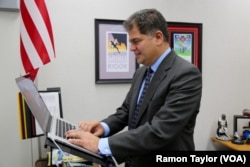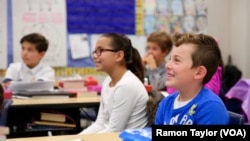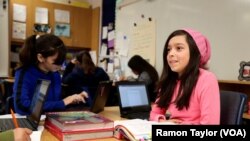Students run through the playground of the terra-cotta Salt Creek Elementary School in Chula Vista, California, a border town 15 kilometers north of Mexico.
A few laugh, skip and jump to the side, while the majority play a game involving a concrete wall — similar to “wall ball” — but using extended arms and fists and a black-and-yellow soccer ball. Coincidentally, half of the students are on one side and the rest on the other. But they are free to cross at any time, united by friendship.
Some of the students are originally from Tijuana and speak Spanish at home and possess various levels of English proficiency in the classroom. But all who attend share their traditions and learn from one another, including each other’s mother tongue. Many of them traverse two countries both by foot and identity.
“All of my aunts and uncles speak Spanish — and my brother and sister and my mom and my dad. I’m the only one that speaks English,” said Lucia, a fourth-grader. “When I’m home, I tell my mom good morning,’ I don’t say ‘buenos días.’”
Lucia says it’s important to speak English because it’s what her best friends mostly use at school, but says maintaining her Spanish is important when visiting her grandparents in Mexico.
“I feel happy ... that I see them, because sometimes time flies,” she said, in English. “I better stay with my grandparents until they’re gone.”
‘Safe haven’ district
Following the 2016 presidential campaign, Tom Torlakson, California’s State Superintendent of Public Instruction, encouraged state public schools to be declared “safe havens” for students in light of fears among undocumented families that they could be deported under then president-elect Donald Trump.
Chula Vista Elementary School District Superintendent Francisco Escobedo, who oversees 45 schools in the border region, told VOA it was important to address the topic of sanctuary with parents and teachers, which he penned in a letter, both in English and Spanish.
“I received an email … from a teacher thanking me for that letter that helped her talk to her child and ease his fear, because he came to school crying,” Escobedo said. “He came to school in fear that someone will come and remove him from the classroom.”
Watch: Multicultural Kids in Safe Haven School District Learn From Each Other
Dual-immersion
Serving nearly 30,000 students, Chula Vista Elementary School District is the largest in the state of California, and one of the most diverse: 68 percent are Hispanic, 35 percent are learning English.
In multiple years, its schools have received the National Blue Ribbon, a U.S. Department of Education-designated award that honors high-achieving schools that help to close the achievement gap among disadvantaged students.
According to Escobedo, much of the district’s success can be attributed to its dual-immersion program, which strives for multiliteracy and bilingualism.
“Twenty-one of our schools are dual-immersion schools, so we see Spanish as an asset, not a liability,” he said. “We use that richness they come with and build upon it.”
“Our students come and go from both countries,” added Emma Sanchez, the district’s executive director of language and instruction. “We want to empower and build our teachers’ capacity to support the children in both languages.”
A desert island
In her sixth-grade classroom at Otay Elementary School, Valeria is assigned a narrative: she and her classmates are ancient Egyptians, stranded on a desert island. Her eyes beam with curiosity and imagination.
Valeria describes her life as ideal in her ability to move regularly across the border. During the weekend, she visits her dad in Tijuana, where she grew up. But back at home, just north, she speaks Spanish with her mom.
“I get to learn more stuff from TJ, and I get to learn new things here,” she said. “You learn different things that they do, like Mexican dances and how you cook Mexican food, and I like it a lot,” she said.
As she finishes her thought, Valeria smiles and turns gently to her assignment — another world and culture entirely, now part of her own.
Arturo Martinez contributed to this report.















